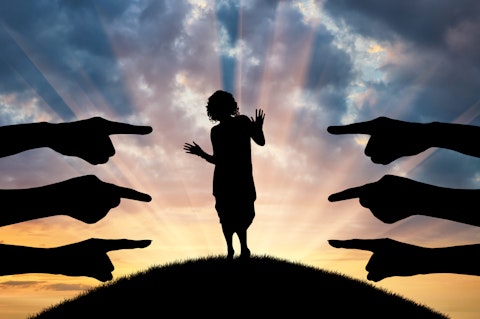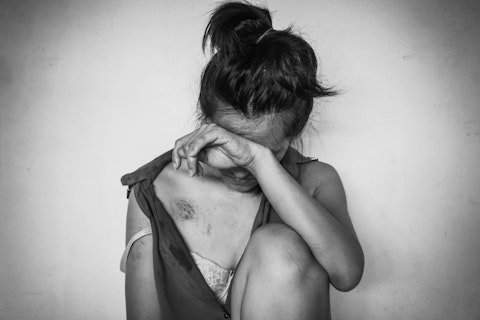In this article, we will take a look at the 20 most sexist and misogynistic countries in the world.
Misogyny is typically defined as a “hatred of, aversion to, or prejudice against women.” Others like Joseph Swetnam, who authored a text called The Arraignment of Women, said that women were twisted by nature, wily, clever, dishonest, treacherous, with a bite worse than an old dog and a hungry flea; they stemmed from the devil and were the foundation of all evil. According to Aaron, “they were like pumice stones because their hearts were filled with holes…like painted ships because they looked pretty but contained only lead.” The major purpose of online misogyny is to sustain the patriarchal system and reinforce sexist norms that impose and normalize male domination and push women out of online spaces. Yes, misogyny is evident online as well.
For years, online sexism has been reported on social media platforms. Worst, this includes not only the use of derogatory and violent rhetoric against women, but as well as justification or even praise of women’s maltreatment. Millions of women and girls over the world have reported being subjected to this kind of abuse. Some believes that misogynistic language may also be seen as a reaction to evolving societal standards regarding women’s responsibilities. Recent reports indicate a potential increase in hate speech directed at women on various social media platforms since the onset of COVID-19. Violence against women has unquestionably increased during the COVID-19 pandemic, primarily in the form of intimate partner violence. It is possible that increased financial stressors and isolation during the pandemic contributed to this increase.
Chris Wilson of the Department of Politics and International Relations in University of Auckland in New Zealand asserts that the same Western nations that are currently dealing with a surge of violent assaults on synagogues, shops, schools, and other populated areas are also the same nations that have dealt with very similar attacks spurred on by a particularly modern brand of sexism. Thus, to determine whether or not this is the case, in this article, The 20 most sexist and misogynistic countries in the world will be uncovered.

Prazis/Shutterstock.com
Our Methodology
To determine the 20 most sexist and misogynistic countries in the world, extensive research was conducted using articles from five sources (1, 2, 3, 4, 5, and 6). One point will be awarded to a nation’s total whenever that country’s name appears on the list of any given source. Following the compilation of this information, a ranking was devised to determine the 20 most sexist and misogynistic countries in the world.
So here are the 20 most sexist and misogynistic countries in the world.
20. Oman
Oman ranks 20th in our list of the most sexist countries 2023. In Oman, there have been ongoing conflicts regarding gender equality and the denial of fundamental human rights. Freedom of expression and peaceful assembly are limited for all citizens of Oman, both men and women. Regarding freedom of movement and residency, women have the same rights as men, but they are severely unprotected in other areas, such as divorce and custody. Longstanding discrimination based on gender exists in Oman, but efforts have been made to combat it.
19. Algeria
In male-dominated environments, female activists have long opposed their marginalization in Algeria. The Algerian women’s struggles can be traced back to the revolutionary conflict of 1954–1962. Despite these efforts, discrimination and misogyny continue to be pervasive. In Algeria, the discriminatory perception of adolescent girls and women has a significant impact. The lack of symmetry between gender entities can be traced to the nation’s cultural, religious, and legal structures, in which women are frequently regarded as subordinate to men. In Nigeria, women are subject to various perversions, yet the legislature enacts incredibly discriminatory and exclusive legislation.
18. Nigeria
Nigerian women have spoken out against discrimination and advocated for gender equality. Despite these efforts, sexism and misogyny are pervasive and prevalent. In Nigeria, misogyny continues to be dominant. Misogyny is still a daily obstacle for women. The impact of the sexist perception of adolescent girls and women in Nigeria is significant. The lack of symmetry between gender entities can be traced to the nation’s cultural, religious, and legal constructs, in which women are frequently viewed as subordinate to males. In Nigeria, women are subject to various perversions, yet the legislature enacts extremely discriminatory and exclusive laws.
17. India
A quarter of Indians (23%) believe there is “considerable discrimination” against women in their country. In addition, 16% of Indian women reported experiencing gender-based discrimination in the 12 months before the survey was conducted in 2019–2020. In addition, three-quarters of adults consider violence against women a significant issue in Indian society.
16. Saudi Arabia
Women in Saudi Arabia face systemic discrimination and domestic violence due to the male guardianship system. They have few remedies when abused, prompting some women to attempt hazardous escapes. By a wide margin, Saudi Arabia’s laws and regulations and the government’s endeavors to enforce them are the most stringent in the world. For instance, Saudi Arabia restricts the mobility of its female population more than any other nation. Moreover, the Saudi government restricts a woman’s freedom to marry by requiring her to obtain the consent of a male guardian. As in other countries, domestic violence affects many Saudi women. Unlike Saudi men, Saudi women cannot study abroad on a government scholarship without parental consent, and the rules require a male relative to accompany them throughout their studies abroad, though this is not consistently enforced.
15. Iran
Women in Iran have been at the forefront of politics for over a century. By the time of the Iranian Revolution in 1979, they had gained the right to vote and initiate divorce, among other liberties. However, even though women and girls are treated as second-class citizens, urgent reforms are still required. Child marriage is one of the most concerning issues affecting the rights of women and girls in Iran today. By law, a girl as young as 13 may marry, and females even younger may marry with parental and judicial consent. Existing safeguards against violence are insufficient to secure women and children comprehensively.
14. Somalia
Somalia has higher female political representation than the Central African Republic. However, the percentage of women in the labor force is significantly lower. In Somalia’s’srotracted cycle of conflict, the indicators for achieving the Sustainable Development Goal of gender equality in the country are sometimes insufficient. There are troubling gaps in reporting, including data on women’s land ownership rights, harassment and violence against women, and the gender pay disparity. Moreover, more than one-third of Somali women marry before they are 18. Only 2% of women in the country had access to modern and secure birth control and family planning resources. This has resulted in one of the highest maternal mortality rates in the world.
13. Niger
Systematic maltreatment of a disproportionate number of women and girls is experienced in Nigeria. Nigeria has a high prevalence of sexual harassment against women at 38.1%. Moreover, school enrollment is low in Niger, particularly among females, those from rural areas, and the most vulnerable.
12. Mauritania
Mauritanian women’s rights are among the worst in the world. Islamic law (sharia), which prohibits women’s social and fiscal independence, is one of the factors that restrict women’s roles in Mauritanian society. Girls’ education is primarily limited to Quranic schools, which provide them with minimal literacy skills. Since there are no schools in many villages and rural cities, and even in major cities, they are prohibited from teaching in conventional schools. Women in Mauritania have an exceedingly low status and face discrimination regarding employment, education, healthcare, and even freedom of movement. Women who want a better existence must leave their families and relocate to a major city.
11. Central African Republic
In the Central African Republic, women experienced sexual harassment four times more frequently than men. Additionally, women encountered sexual harassment, with others claiming to have witnessed it multiple times. This harassment could have originated from a coworker or management. The lack of organizational support is troubling in the Central African Republic. This indicates that sexual harassment is prevalent in newsrooms across these nations. It also demonstrates that the discriminatory environment discourages participants from reporting harassment to their organization. This perpetuates a hazardous and hostile workplace.
10. Mali
In Mali, where poverty and insecurity are pervasive, education is a child’s best opportunity for an improved future. This is why giving females the same opportunities as boys is a top national priority, with significant efforts being devoted to doing so for equal opportunity for all students and the nation’s future. Creating learning environments that are female-friendly requires awareness and community involvement. Once there are national gender policies, there is an awareness of inequalities, and for this educational planner, this is the first stage in eradicating discrimination and disadvantage.
9. Iraq
Women comprise half of Iraq’s population, yet they are virtually invisible in the public sphere. In this highly conservative society, a woman’s position is hidden from view—not at school or work but at home. In Iraq, females are twice as likely to be illiterate as males. According to UN statistics, only 14 percent of women are employed, compared to 73 percent of men. Instead of pursuing higher education and a career, Iraqi women are expected to marry and be submissive spouses and mothers. Almost half of married women have experienced emotional, physical, or sexual domestic violence. Domestic violence, forced marriage, “honor” crimes, and rape are among the many dangers Iraqi women confront.
8. Sierra Leone
Sierra Leone is comparable to numerous young African democracies with a violent past. Sierra Leone struggles with patriarchal attitudes and violence against women. In Sierra Leone, only a few women, especially married women, perceive themselves to be authentically protected by this law and similar ones. Even some forms of violence are viewed as necessary and permissible in Sierra Leone. In addition, women who do report the risk of losing security for themselves and their children The state legal system and the police also do not prioritize cases involving married women; they often advise women to resolve the issue privately rather than through the courts.
7. Yemen
In Yemen, which has been ranked at the bottom of the World Economic Forum’s Global Gender Gap Index for thirteen consecutive years, women have endured gender inequality rooted in a patriarchal society with rigid gender roles. Women have been disproportionately affected by the conflict in Yemen, which has had a devastating impact on all Yemeni civilians. Harmful gender stereotypes, patriarchal attitudes, a discriminatory legal system, and economic inequality have exacerbated the vulnerability of women to violence.
6. Syria
The Syrian civil conflict has gendered effects on attacks on healthcare facilities in Syria. This is notably true regarding mental health and psychiatric support. For example, women spend less time than men in public spaces and are expected to have fewer interactions there. Explosive weapons may amplify these gendered norms by making it even more dangerous for women to spend time in the streets, hospitals, and marketplaces. Therefore, access to psychiatric facilities may be hazardous for Syrian women. 59% of female Syrian refugees residing in Turkey were unaware of the mental health services available to them, according to a report by UN Women.
5. Chad
Twenty years ago, Chad passed its Reproductive Health Law, which has led to a significant decline in practices such as female genital mutilation. Concern published a report in 2015 indicating that the median age for a first marriage for females was 16, and for boys, it was 22. In one focus group for this report, a participant stated, “Early marriage is a tradition in our community, but it poses a real threat to the girl: pregnancy, surgery, death, and several instances of running away.”

4. Sudan
Sudan is a developing country that confronts numerous obstacles in terms of gender inequality. Sudan is also among the few nations that have not adopted the Convention on the Elimination of All Forms of Discrimination Against Women (CEDAW). Women comprise a larger proportion of the national parliament in Sudan than in many Western countries. Despite this, the international community is concerned about gender disparities in Sudan, particularly concerning female genital mutilation and the discrepancy between women and men in the labor market.

Copyright: highwaystarz / 123RF Stock Photo





